trabeation - In architecture, a beam or lintel.
tracer - A chasing tool. Also see ciselet.
tracery - In architecture, branching, ornamental stonework, generally in a window, where it supports the glass. Tracery is particularly characteristic of Gothic architecture.
Example:

France, Rose Window of the Cathedral of
![]()

![]() Notre
Dame of Paris, interior view.
Notre
Dame of Paris, interior view.
This exterior view displays the fine stone
tracery.
Work on this cathedral began in 1163 and was completed 1345. See architecture and rose window.
Also see bar tracery, fenestration, flamboyant, foil, quatrefoil, and stained glass.
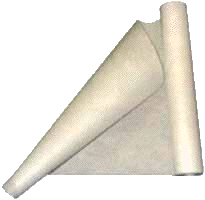
tracing and tracing paper - Making a drawing by referring to an image visible underneath it. Tracing paper is made translucent for this purpose. While artists sometimes use tracing simply as a means of copying another image, and often their own image, they use it best to improve upon images.
Examples of drawings on tracing paper:
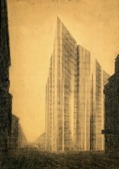
Ludwig Mies van der Rohe (German, 1886-1969),
Friedrichstrasse Skyscraper, Berlin-Mitte, Germany,
a project in 1921, this is a perspective
drawing from
the north, charcoal and pencil on tracing paper
mounted on board, 68 1/4
x 48 inches (173.4 x 121.9 cm), Museum of Modern Art, NY. This
design for a
twenty-story tower
was based on the then-untried curtain
wall idea: that a supporting steel
skeleton would be able to free the exterior walls from their
load-bearing function, allowing
a building to have a surface
that is more translucent than solid. See Bauhaus.
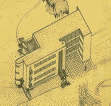
Jacobus Johannes Pieter Oud, architect and
delineator (Dutch, 1890-1963), House for Three Families, 1928, axonometric
projection in ink and pencil
on tracing paper, Carnegie Museum
of Art, Pittsburgh, PA. Oud worked in the style
that evolved from De
Stijl called the International Style.
Also see appropriation, copy, counterfeit, épure, facsimile, forgery, frottage, homage, representation, reproduction, rubbing, and simulacrum.
tracking shot - In video and cinematography, a film segment photographed with a camera moving steadily along a track or on a dolly, usually following a subject's movement. This term has been in use since about 1940. It's also called a trucking shot, or dollying with. A tracking shot should be compared to a zooming shot, but is different from it in significant though subtle ways. A tracking shot can be combined with other kinds of movement, as when the camera is attached to a crane, allowing it to rise or fall as it is tracking. When shooting while walking with a camera produces unwanted vibrations, a camera operator might employ a Steadicam to smooth out such jerkiness.
Also see blow-up, close-up, depth of field, direction, enlarging, jump cut, field of view, pan, panning shot, straight, tilt, and wide-angle shot.
trademark, ® - A company's identity
— name, logo, symbol, design, or other  device — used to show that a product or service is made by a particular
producer and legally registered so that no other person or firm
can use it. Trademarks of successful products and services are
jealously guarded by their owners to prevent competitors from
imitating them. Registration (in the USA with the U.S. Patent
and Trademark Office; internationally by the World Intellectual
Property Organization, under the Madrid Protocol) is indicated
by an encircled "R" following the name ("TM"
if a claim is made to the mark, or if registration is pending),
giving the owner the right to legal redress in case of infringement.
The use of a trademark indicates
that the maker believes that the quality
of the product will enhance his or her standing or goodwill, and
a known trademark indicates to a buyer the reputation that is
staked on the goods. Imitations of a trademark wrong both the
owner of the trademark and the buyer, who is misled as to the
source of the product, and such infringements of a trademark are
punishable by law. Also spelled "trade mark."
device — used to show that a product or service is made by a particular
producer and legally registered so that no other person or firm
can use it. Trademarks of successful products and services are
jealously guarded by their owners to prevent competitors from
imitating them. Registration (in the USA with the U.S. Patent
and Trademark Office; internationally by the World Intellectual
Property Organization, under the Madrid Protocol) is indicated
by an encircled "R" following the name ("TM"
if a claim is made to the mark, or if registration is pending),
giving the owner the right to legal redress in case of infringement.
The use of a trademark indicates
that the maker believes that the quality
of the product will enhance his or her standing or goodwill, and
a known trademark indicates to a buyer the reputation that is
staked on the goods. Imitations of a trademark wrong both the
owner of the trademark and the buyer, who is misled as to the
source of the product, and such infringements of a trademark are
punishable by law. Also spelled "trade mark."
Alternatively, a trademark can be any distinctive characteristic associated with a particular person or his works — something particularly noteworthy that a person typically has or does, such as an artist's characteristic style, medium, technique, or subject. Many artists' signatures are equivalent to their trademarks. James A. M. Whistler had a wisp of white hair on his forehead and a butterfly for his signature.
Examples of trademarked products include Cor-ten, Duco, Kiln-Sitter, Lucite, Masonite, Nirosta, Plasticine, PlexiGlas, Styrofoam, and Velcro.
Art about a trademark:

Edward Ruscha (American, 1937-), Large Trademark with Eight Spotlights,
1962, Whitney Museum of American Art, New York, NY. See Pop Art.
Also see tattoo.
tradigital - Referring to art, especially animation, that combines traditional and computer-generated media. Cinematic examples include Who's Afraid of Roger Rabbit?, Spaceballs, and The Lord of the Rings trilogy. The term was earliest coined about 1995.
See digital imaging, mixed media, and new media.
tradition and traditional - Tradition is the passing along of a culture from generation to generation, especially orally. Or, a custom or set of customs handed down in this way. The idea of heritage is related to that of tradition. Any activity — as a pattern of celebration, ritual, or other behavior, etc. — is traditional once it is a precedent influencing comparable activities in the future.
Tradition's opposite is reaction to it, change, variation from what's been done before, what's different, new or avant-garde.
Example:

Jose Antonio Rios (Peruvian, contemporary) and his family, "Colonial Garlands" Jewelry Box, 2003, tooled leather on plywood, velour lining, height 3.0 inches, diameter 6.3 inches, weight 0.4 lbs. A member of the Rios Family has tooled the leather with hammer and chisel, replicating foliate patterns of vines and garlands, reminiscent of Peru's colonial epoch. Jose Antonio Rios said, "For us, embossing leather is a family tradition. My father inherited it from his father, and handed it down to us."
Quote:
Also see archaeology, civilization, ethnic, ethnosphere, humanities, iconography, memory, modernism, new, periodicity, posterity, time, and tradigital.
tragacanth - A white or reddish gum derived from herbs used as a water-soluble binder.
transcend - To go beyond the limits of. To surpass, as in intensity or power. Going beyond the ordinary range of perception. It may even mean above and independent of material experience or the universe, as in the experience of God.
(pr. tran-SEND)
Also see high art and transcendentalism.
transcendentalism - A philosophy holding that one can transcend experience in order to attain a higher plane of knowledge. May also refer to a literary and philosophical movement that flourished in New England in the middle of the nineteenth century. It is associated with Ralph Waldo Emerson (American, 1803-1882) and Henry David Thoreau (American, 1817-1862), who were influenced by such German philosophers as Immanuel Kant (1724-1802).
transept - An aisle between the apse and nave. It cuts across the nave and side aisles to form a cross-shaped (cruciform) floor plan.
Also see architecture, cathedral, and Gothic.
transfer paper - Paper coated with a packed pigmented powder. When marks are made with sufficient pressure upon the paper's uncoated side, a likeness of those marks is transferred to the surface placed below the transfer paper with the pigments from its coated side. There are many commercial and hand-made types. To make your own transfer paper, rub pencil or crayon marks densely onto an area of paper. Also see carbon paper, copy, frisket, and rouge paper.
transferal - Something that is transferred from one place to another, as an image may be passed from one surface to another by any of several means, including from a printing plate, or from transfer paper. A toy named Silly Putty can do this by being pressed onto dry newspaper inks. Or, the removal of an image from a surface in the act of its being transferred.
Examples:

Antonio Pollaiuolo (Italian, Florence, 1431/32-1498),
Study for an Equestrian Monument, c.
1482-1483, pen and brown ink, light and dark brown wash; outlines of the horse and
rider pricked for transfer, 11 1/8 x 10 inches (28.1 x 25.4 cm),
Metropolitan Museum of Art, NY. See equestrian
art and monument.
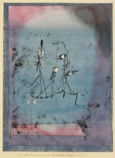
Paul Klee (Swiss, 1879-1940), Twittering Machine, 1922, watercolor and pen
and ink on oil
transfer drawing
on paper, mounted
on cardboard, 25 1/4 x 19
inches (63.8 x 48.1 cm), Museum of Modern Art, NY. See music and Swiss art.

Robert Rauschenberg (American, 1925-), Untitled, 1979, solvent
transfer and fabric collage
on paper, 31 x 22 inches, Kemper Museum
of Contemporary Art, Kansas City, MO. Rauschenberg clipped reproductions from magazines, coated them with chemical solvent, and placed them face down on the drawing surface. The reverse sides of the clippings were rubbed over with a pen, transferring the images onto the paper. Finally, an overlay of transparent washes of gouache and pencil marks was added to allude to different moods or emotional states.
Also see collage, consign and consignment, dry transfer graphics, grid, and pasteup.
transform, transformation - To transform is to change something in shape or appearance. Transformation is the act of doing this. Most definitions of art require that a substance or material be transformed in order for an artist produce to art.
Examples:
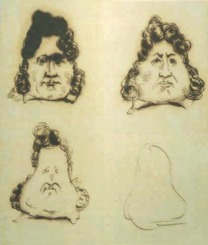
Charles Philipon (French, 1800-1862), La Métamorphose
du roi Louis-Philippe en poire (The Metamorphosis of King Louis-Philippe
into a Pear), c. 1831, pen
and bister-ink drawing, Bibliotheque Nationale de France,
Paris. This set of four sketches
begins with an accurate portrait
of King Louis-Philippe (1830-1848) whose face Philipon gradually
transformed into a pear. The pear immediately was taken as a
symbol of the soft, overweight king.
Louis-Philippe, the so-called "Citizen King" was a
favorite target of republican caricaturists,
including Honoré Daumier, until censorship
was reinstated in September 1835. See metamorphosis.

Montien
Boonma (Thai, 1953-2000), Self-Portrait: A Man Who Admires Thai Art,
1982, photograph altered with
decorative patterns drawn
in colored ink. "The results transform
his image into a traditional
Thai theater mask while also giving
it a smirky, challenging version of the welcoming "Siamese
smile" of tourist industry cliché,"
said Holland Carter, New York Times, Feb. 21, 2003. See
self-portrait.

Cindy Sherman (American, 1954-), Untitled A, 1975, photograph on paper, 41.4 x 28.3 cm, Tate Gallery,
London. Since the mid-1970s, Sherman has photographed herself,
not to make self-portrait,
but to picture herself posing as characters she has invented.
She has made many series of such photos, in which she has transformed herself through the use
of cosmetics, costumes, hairstyles,
body language and facial expressions.
See model and theater.
Quote:
Also see anamorphosis, interdisciplinary, metamorphosis, and theater.
transgressive art - Art that confronts or breaks one or more social taboos. Transgressive art is a shocking art, designed to insult social conservatives of one sort or another. Social conservatives typically consider transgressive art scandalous.
The appearance of transgressive art in the modernist movement can be ascribed to the Enlightenment, the late 18th and mid 19th centuries revolutions in France and other European countries, and reactions to bourgeois values and wars of the period.
Examples:
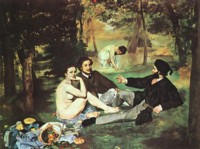
Édouard Manet (French, 1832-1883), Luncheon on the Grass (Le Déjeuner sur l'herbe), 1863, oil on canvas, 81 x 101 cm, Musée d'Orsay, Paris. Rejected by the Salon of 1863, this caused a scandal when it appeared in the Salon des Refusés. Popular indignation arose because a classic, pastoral subject had been reinterpreted as an image of contemporary life — a nude woman picnics with a pair of men who wear contemporary, middle-class clothing — a provocative hybrid of the sacred and the secular, the highbrow and the pornographic. See gaze and Realism.
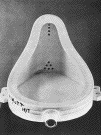
Marcel Duchamp (French-American, 1887-1968), Fountain, 1917, white glazed ceramic plumbing fixture and painted signature, readymade porcelain urinal on its back, 63 x 48 x 35 cm. The urinal, purchased from "Mott Works" company in New York and signed "R. Mutt," was submitted to the jury-free 1917 Independents exhibition but was suppressed by the hanging committee. The term transgressive art was not applied to this work in 1917, but could be employed in discussing Fountain in light of Duchamps' intentions. This is a photograph of either the second version of 1951 or the third of 1964. The Georges Pompidou Centre in Paris has published a color photo of Fountain. See Dada and fountain.
Robert Mapplethorpe (American, 1946-1989), Self-Portrait from the "X Portfolio", 1978, a photographic self-portrait in which a whip protrudes from Mapplethorpe's anus. See gender issues.
![]()

Andres Serrano (American, 1950-), Piss Christ, 1987, photograph of a crucifix submerged in urine.

Chris Ofili (British, 1968-), Holy Virgin Mary, 1996, paper collage, oil, glitter, polyester resin, map pins, elephant dung on canvas, 243.8 x 182.9 cm.
Anthony Julius a contemporary British lawyer and author, identifies the five most common defenses of scandalous art:
Reference:
Julius, Anthony. (2003). Transgressions: The Offenses of Art. University Of Chicago Press.
Also see anti-art, avant-garde, bad art, censor, Center for Arts and Culture, culture, degenerate, eccentric, edge, erotica and erotic art, fig leaf, frisson, grotesque, gymnophobia, heterodox, iconoclasm, iconomachy, iconophobia, issue, obscene, parody, political correctness, pornography, satire, ugly, vandalism, voyeurism, vulgar, and xenophobia.
translucent - Allowing some light to pass through, but greatly obscuring the image of objects on the other side. A quality that is between transparent and opaque. Materials that may be translucent include glass, papers such as glassine, plastics such as Lucite and PlexiGlas, and porcelain. It is quite possible for one person to describe something as translucent if it is merely tinted, and for another to describe it as transparent because it is so easy to see through it clearly.
Examples:

American, Wurlitzer Company, Jukebox, Model 1015, 1946. This design includes
numerous translucent components lit from within, their colors
changing periodically.
Streams of bubbles rise inside the vertical lamps on the left
and right edges of its façade.
56,242 of this model were produced. It's capable of playing 24
selections. Visit the Wurlitzer Jukebox Company to see every model
the company has ever produced, including the currently produced
version of this one. See music
and popular culture.

André Kertèsz (Hungarian, 1894-1985), January 1, 1972, Martinique, 1972, gelatin-silver print, 7 5/8 x 9 11/16 inches (19.37 x 24.61 cm), Los Angeles County Museum of Modern Art. We see that a person is leaning on the railing on the other side of a translucent screen. See photography.

France, Blue-Violet Jellies, cast
polyvinyl chloride (PVC)
sandals. Plastic sandals have been produced since the late 1940s.
See costume
and design.
Also see alabaster, blanc de Chine, double-exposure, kaleidoscope, polyethylene, resin, stain and stain removal, transparent, and wash.
transparency - A picture on a transparent surface, such as glass or photographic film, so that the picture can be projected onto a flat white surface. Examples are photographic slides. Also, the quality of being transparent.
Also see camouflage, erasure, and translucent.
transparent - Allowing light to pass through so that objects can be clearly seen on the other side; the opposite of opaque. Window glass, cellophane and watercolors are usually transparent. It is quite possible for one person to describe something as translucent if it is merely tinted, and for another to describe it as transparent because it is so easy to see through it clearly. Portions of GIFs and other digital images are transparent when image layers "behind" others are allowed to be seen without modification. The photo of tracing paper above is an example of a "transparent GIF."
Other examples of transparent:

Mike Doughty (American, contemporary), demonstration
of a Cool Transparent Text Effect in PhotoShop — the word
"TEXT" placed within an image of a cloudy sky so that
the lettering appears transparent. Another way to interpret this
effect: the surface of this
photograph seems to have been
embossed with lettering.
See illusion and simulation.
![]()

![]()
Speaker System, a digital
image, rendered as if
the exterior of the case for the speakers were transparent.

American, transparent plastic computer part beside
a translucent plastic bag and opaque screws on a green cutting
mat, 2002. See design.
Also see cutaway, lens, mirror, pixel shim, polyethylene, vitrine, and wash.
trapezium - A quadrilateral having no parallel sides. The plural form can be either trapeziums or trapezia. Trapezium is sometimes used as a synonym for trapezoid, especially by Britons.
Also see parallelogram, polygon, rectangle, rhombus, and square.
trapezoid - A quadrilateral with one pair of opposite sides parallel, but the other two are not parallel. The formula with which to find a trapezoid's area is the distance between the parallel sides times half the sum of the lengths of the two parallel sides.
Also see parallelogram, polygon, rectangle, rhombus, square, and trapezium.
tratteggio - In art restoration, the contemporary School of Rome scientific method of restoring ancient frescoes. The missing parts are filled, smoothed and then touched up (a reversible procedure) by means of watercolor applied with vertical brushstrokes giving a harmonized visual effect from afar but visible to the naked eye from close to. More recently and for Augustan-period paintings whose surface is burnished, watercolor is applied in a myriad of pinpoint dots, a sort of very closely-knit "pointillé". (Much of the preceding information verbally reported by Ms. Alix Barbet to George Ortiz in 1993, used in Ortiz's definition of tratteggio, quoted here from the George Ortiz Collection.)
Example:
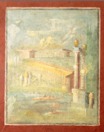
Roman, Stabiae, Landscape, c. 40 CE,
fresco "end of
Third Style", scene: 66.2-66.6 x 52.3-52.8 cm, white border:
2-7 mm, red wall: 7.7-15.5 cm, George Ortiz collection. The trattegio
in this fresco has been applied to a very small area just below
the pair of figures in the upper third of the picture. Concerning
its use here, Otiz's catalogue entry states: "In the present
case, the restorer has made an exception to the rule by using
both vertical and horizontal brushstrokes." See landscape.

travertine - A limestone characterized by irregularly shaped hollows. It is used most for architecture (often cladding other materials), and is also used for outdoor sculpture. Travertine is quarried in the Tiber Valley near Rome.
trecento - Italian, literally "three hundred," it refers to the 1300s — the fourteenth century. It is especially used to refer to Italian art of that century, the time of the Middle Ages.
Examples of works of the Italian trecento:

North Italian Painter, first quarter 14th
century, Two
Angels, fresco;
(the one shown) 23 3/8 x 31 1/2 inches (59.4 x 80 cm); (the second)
23 1/2 x 31 1/2 inches (59.7 x 80 cm), Metropolitan Museum of
Art, NY. See angel.

Giotto di Bondone (Italian, Florentine, 1266/76-1337),
The Epiphany, possibly c. 1320, tempera
on wood, gold ground,
17 3/4 x 17 1/4 inches (45.1 x 43.8 cm), Metropolitan Museum
of Art, NY. (On the Met's page, you can enlarge any detail.)
See perspective.

Giotto di Bondone. This is one of two views Giotto painted side-by-side
using herringbone perspective. These scenes are interiors
of what appear to be sacristies or a choir, in perfect perspective.
The effect is so realistic that we feel we are looking into actual
rooms. Our gaze moves beyond the ogival arch to the cross-vault
of each room, and thence to the Gothic mullioned window. That
the two symmetrical chapels appear to have approximately the
same vanishing point is an astonishing anticipation of the fifteenth-century
perspective system. Though their significance was once ignored,
these small scenes are now recognized as an extremely important
phase in the development of Giotto's conception of pictorial
space. See perspective.

Simone Martini (Italian, c. 1284-1344), Madonna from the Annunciation, 1340-1344,
tempera on wood
panel, 12 x 8 1/2 inches (30.5 x 21.5
cm), State Hermitage Museum, St. Petersburg, Russia.

Italy, Florence, The Flagellation, mid-14th century, needlework
panel with silk and metal thread on linen,
10 1/2 x 16 inches (26.7 x 40.6 cm), Metropolitan Museum of Art,
NY. See textile.
| Italian term | Numerically | English term |
|---|---|---|
| duecento | 1200s |
thirteenth century |
| trecento | 1300s |
fourteenth century |
| quattrocento | 1400s |
fifteenth century |
| cinquecento | 1500s |
sixteenth century |
| seicento | 1600s |
seventeenth century |
| settecento | 1700s |
eighteenth century |
| ottocento | 1800s |
nineteenth century |
| novecento | 1900s |
twentieth century |
| diecicento | 2000s |
twenty-first century |
Also see Gothic.
trencadis - Trencadis is a Catalan word (the language of Catalonia, in northeastern Spain) for a type of mosaic in which shards from waste tiles are used to clad buildings, a practice comparable to pique assiette (also called picassiette).
Architect Antoni Gaudí (Spanish, 1852-1926) employed trencadis to great effect in several projects. He was fortunate to have a number of ceramics factories nearby. His collaborator, Josep Maria Jujol (Spanish, 1879-1949) developed this technique further, breaking and reassembling new tiles. In addition to the mosaics produced in Barcelona's Güell Park ("Parc Güell" in Catalan), he incorporated broken colored glass bottles, plates from his own kitchen, and even fragments of a porcelain doll. At the beginning of the twentieth century, this kind of found material assemblage or collage approach was highly innovative. The assemblage and collage works of artists who visited the Guell Park, most notably Pablo Picasso (Spanish, 1882-1973) and Salvador Dalí (Spanish, 1904-1988) apparently took root in Gaudí and Jujol's work.
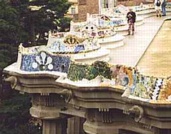
Antoni Gaudí (Spanish, 1852-1926)
and Josep Maria Jujol (Spanish, 1879-1949), the serpentine bench
at Güell
Park (Parc Güell), 1900-1914, trencadis, Barcelona,
Spain.
![]()

![]()
![]()
Telephoto
shot of the top of the bench.


Details of the bench.
See meandering, serpentine,
and telephoto.
Also see Cubism and Surrealism.
triad - Three colors equally spaced on the color wheel. For example, red, yellow and blue form a triad, as do orange, green and violet, and so on. Also see analogous colors, color scheme, complementary colors, intermediate colors, monochrome, primary colors, secondary colors, split complementary, and triangle.

triangle - A closed two-dimensional polygon bounded by three straight-line segments. The sum of its interior angles is always 180°. The formula with which to find an equilateral triangle's area is 0.433 times the length of one side squared. The formula for finding any triangle's area: half of the longest side multiplied by its height.
An example of a triangle in art:

Ellsworth Kelly (American, 1923-), Yellow Red Curve, 1972, oil
on canvas, 115 x 302 cm, Georges
Pompidou Center, Paris. See Minimalism.
Quote:
"On a square lattice at least one
coordinate of an equilateral triangle must be irrational. An
irrational number has no finite numerical representation. An
equilateral triangle represented on a computer is inherently
imprecise."
Ken Goldberg (born Nigeria, 1961-), American artist.
Related resources:
Also see mathematics, positive, regular, shape, spandrel, and vertex.
tricesimo-segundo - A book or manuscript of the next size smaller than an vicesimo-quarto. Tricesimo-segundo is abbreviated 32mo, sometimes pronounced "thirtytwo-mo." This is the smallest size. Also see bookbinding, duodecimo, folio, miniature, octavo, quarto, sextodecimo, and signature.
trident - In Hindu art the trident is one of the attributes of the god Shiva. The three prongs represent Shiva's powers as a creator, protector and destroyer. The trident may also appear as an attribute of gods in Shiva's circle. In Greek mythology, the trident is an attribute of Poseidon; and in Rome of his counterpart, Neptune.
Example:
![]()

![]()
Greek, detail of a vase painted with a picture of Amphitrite,
Nike, and Poseidon. See Nike.
![]()
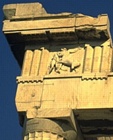
![]() triglyph
- An ornament in a Doric
frieze, consisting of a projecting
block having on its face three
parallel vertical
glyphs (protruding vertical
bars) and two half grooves or chamfers
on either vertical end, with metopes
on either side of all but the first and last on a side.
triglyph
- An ornament in a Doric
frieze, consisting of a projecting
block having on its face three
parallel vertical
glyphs (protruding vertical
bars) and two half grooves or chamfers
on either vertical end, with metopes
on either side of all but the first and last on a side.
(pr. TRI:-glif)
Example:
Triglyphs as they figure into a diagram of the Doric order, but not into a diagram of the Ionic order.
Also see abacus, architrave, base, capital, classical orders, column, Corinthian, cornice, echinus, entablature, Greek art, Ionic, orders, Roman art, shaft, and stylobate.
trit - The smallest possible particle of a substance. Shortened form of triturate.
Also see clean up, filter, hazardous, plaster, and sand.
triturate and trituration - To grind, crush, pound, or rub into a very fine powder as with a mortar and pestle; or a triturated substance. Trituration is the process of triturating.
trois crayons - A French term for a drawing technique requiring the monochromatic combination of red, black, and white chalk, usually on tinted paper.
(pr. twah kray-OH)
Example:

Jean-Antoine Watteau (French, 1684-1721),
Two Studies of a Flutist and a Study of the Head
of a Boy, about 1716-1719, red, black, and white chalk on buff-colored
paper, 8 7/16 x 13 3/16 inches (21.4
x 33.6 cm), J. Paul Getty Museum, Malibu, CA. See Rococo.
trope - The figurative use of a word or an expression; a figure of speech. A trope might be a metaphor, hyperbole, metonymy, synecdoche, irony, parody, etc.
Also see taxis.
true-color image - In digital imaging, generally refers to 24-bit or better images.
truncate - To shorten by cutting off, or as if by cutting off. Or, appearing to end abruptly, as if cut off.
trussel - The upper or hammer die used in striking coins.
Also see numismatics.
trustees - In museums, a group of people who make decisions for acquiring new pieces for the collection, develop budgets, help raise funds, and set policies for the museum's operations.
truth - Conformity to fact or actuality. Veracity. Being in accord with fact or reality. Expressing integrity. Truth is a comprehensive term that in all of its nuances implies accuracy and honesty. Verisimilitude is the quality of having the appearance of truth or reality. A belief of some modernist painters, especially Abstract Expressionists, is that to produce an illusion of depth is dishonest — that a work is more truthful when it declares its inherent flatness. Postmodernists have rejected this notion. Other opposites to truth: counterfeit, fake, forgery, plagiarism, ostentation, and pretentiousness.
"Truthiness" was coined in 2006 by satirist Stephen Colbert (contemporary American), who defined it as "truth that comes from the gut, not books." Colbert apparently sensed the need for this word when discussing utterances of US President George W. Bush. The dictionary publisher Mirriam-Webster declared "truthiness" Word of the Year for 2006 because this word best summed up the year.
Quotes:
Also see Abstract Expressionism, droit moral, likeness, mirror, mystery, naturalism, problem, realism, and quotations.

T square - A long, flat ruler that is attached to a short piece that makes it look like a "T." The short piece slides along the edge of a drawing board to position the ruler so parallel lines can be drawn.
Also see compass, protractor, and triangle.
tsukuri-e - In Japanese art, a painting technique in which initial outlines are hidden beneath layers of color, and a visible outline is added last.
![]()

![]() tubimangulate and
tubimangulation - To squeeze a tube of paint
or other material in an especially
sloppy way. If tubimangulation is accompanied by the obstruction
of flow in material at the spout, try opening the other end, either
by unrolling or by cutting, and close with a paperclip.
tubimangulate and
tubimangulation - To squeeze a tube of paint
or other material in an especially
sloppy way. If tubimangulation is accompanied by the obstruction
of flow in material at the spout, try opening the other end, either
by unrolling or by cutting, and close with a paperclip.
(pr. TOO-bə-MAN-gyə-layt)
Also see brush cleaner, clean up, kiss of death, and solvent.
![]() [
[ ![]() Just kidding!
Just kidding! ![]() I coined this term myself! - M.D.
I coined this term myself! - M.D.![]() ]
]
tunnel - See vault.
turning - A pottery technique by which the base of a pot is trimmed and finished on the potter's wheel. The pot is first allowed to dry to the leather-hard stage.

turpentine - A high quality
oil paint thinner
and solvent. It is produced
by distilling into a volatile
pungent oil the resin
secreted by any of several types of coniferous trees. There are
several grades of turpentine, the best usually called pure gum
spirit of turpentine and the lowest called wood
turpentine. In normal uses it poses ![]() neither hazard
of flammability nor of health
risk, although it is moderately toxic
by skin contact, inhalation, and ingestion. Most adults find its
odor inoffensive, or even pleasant. But for those who find turpentine's
odor disagreeable (including many children), a deodorized type
is available, which is much more expensive. A much less expensive
substitute used by many artists, and for nearly all industrial
applications is mineral spirits,
which is produced from petroleum.
neither hazard
of flammability nor of health
risk, although it is moderately toxic
by skin contact, inhalation, and ingestion. Most adults find its
odor inoffensive, or even pleasant. But for those who find turpentine's
odor disagreeable (including many children), a deodorized type
is available, which is much more expensive. A much less expensive
substitute used by many artists, and for nearly all industrial
applications is mineral spirits,
which is produced from petroleum.
Also see fat over lean, stain, stain removal, and Venice turpentine.
turps - Turpentine.
turret - A small tower, usually containing stairs, that is located on the top of a building.
tusche - In serigraphy and lithography, a black liquid used most with brush or pen to paint a design. It should never be called lithographic ink, which is another substance entirely.
(pr. toosh)
24-bit image - A digital image, with 24 bits allocated for the storage of each pixel, meaning 16 million colors are possible.
Also see true-color image.

twist drill - A drill with a straight shaft incised with spiral cutting edges for boring a hole.
Also see wood.

![]() 2-bit image - A digital image with two bits allocated for the storage of each pixel, meaning four monochromatic colors are possible — a
2-bit image - A digital image with two bits allocated for the storage of each pixel, meaning four monochromatic colors are possible — a gray scale (or value scale) of four values. An earlier generation of Americans would think an image called 2-bit worth twenty-five cents.
Also see 1-bit image, 3-bit image, 4-bit image, 8-bit image, 12-bit image, 16-bit image, 24-bit image, and 32-bit image.
two-dimensional - Having height and width, but no depth; flat.
Also see pasteup, polypropylene, and three-dimensional.

two-point perspective - An application of linear perspective in which all lines (representing straight edges that go from points nearer to points farther) appear to meet at either of two points on the horizon. Here's how to draw in two-point perspective.
Also see depth, horizon line, and one-point perspective.
tympanum - In architecture, the half-round panel that fills the space between the lintel and the arch over a Romanesque or Gothic doorway. It is a perfect place for relief carvings.
Examples:

![]()

France, Conques, Tympanum over the entrance
to the Abbey Church of Sainte-Foy,
mid-11th-12th century, Romanesque.
The subject of this stone
carved in high relief is Christ presiding at the Last
Judgment. A
photo of Sainte-Foy, as seen from the hills above it.

Louis Sullivan (American, 1856-1924), Northwestern
Terra Cotta Works, Norweta, Lunette, 1884-1885, Minneapolis Institute
of Arts. Although the museum calls this a lunette,
perhaps it could also, or would better be called a tympanum?
See Prairie style.
-type - A suffix (word ending) referring to something beaten, struck, or molded, or, by extension, printed. Examples: antitype, archetype, prototype, stereotype, and terms for various printing processes or impressions: autotype, calotype, chryssotype, collotype, cyanotype, electrotype, ferrotype, logotype, phonotype, phototype, platinotype, stereotype, and teletype.
Also see -gram, glyph, and -graph.
type and typeface - In typography, type is a letterform produced electronically or photographically, most often with a computer. Before computers took over this function in the late twentieth century, type was a small block of metal or wood bearing a raised letter or character on the upper end that leaves a printed impression when inked and pressed on paper. This heritage has given us a huge vocabulary of terms we use in reference to type. "Type" can also refer to the full range of type of the same design. A "typeface" is the design of a full set of letterforms, numerals, punctuations and other characters unified by consistent visual qualities.
About type:

German, two 16th century woodcuts:
first:
the casting of type in a mold, and second: two men work the press,
while behind them, another man sets the type. In the
history of type, an important early innovation was the use of
movable type. Johann Gutenberg (German, c. 1400-c.
1468) gets credit for this invention. In order to make movable
type possible, individual letters of type had first to be produced.
See incunabulum.
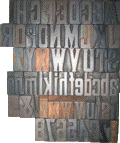
Page and Setchell Company (American), one
of this company's seventeen styles of types, 1887, die-cut
wood.
Also see align and alignment, calligraphy, dry transfer graphics, font, graphic design, italic, lettering, lowercase, pica, point, Roman, serif, sans serif, shank, text, and uppercase.
typography - The design, arrangement, style, and appearance of type matter constitute typography. Among other things, students of typography learn about the uses of various type fonts, including serif and sans serif, capital and lowercase letters, boldface, italic, and condensed type, letter spacing (and kerning), point sizes, and the various factors affecting readability.
(pr. ti:-PAH-grə-fee)
Examples of works in which typography is important:
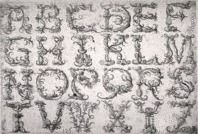
Daniel Hopfer (German , c. 1470-1536), Alphabet of Capital Roman letters with metaphorical
ornaments, 15th-16th century, etching, 15.6 x 22.6 cm (image) inches,
Fine Arts Museums of San Francisco, CA. See ornament.
Albrecht Dürer (German, 1471-1528),
author; Parisiis: Officina Christiani Wecheli, 1535, Publisher,
.jpg) De
Vrbibvs, arcibvs, castellisque condendis, ac muniendis rationes
aliquot, præsenti bellorum necessutati accommodatissimæ,
Paris, Ex officina Christiani Wecheli, 1535; bound with Institutionum
Geometricarum libris, lineas, 1535, printed book;
[78] p.: ill. ; 35 cm, Metropolitan Museum of Art, NY.
De
Vrbibvs, arcibvs, castellisque condendis, ac muniendis rationes
aliquot, præsenti bellorum necessutati accommodatissimæ,
Paris, Ex officina Christiani Wecheli, 1535; bound with Institutionum
Geometricarum libris, lineas, 1535, printed book;
[78] p.: ill. ; 35 cm, Metropolitan Museum of Art, NY.
Illustrated:
methods of constructing letterforms, from
Book 3 of Institutionum Geometricarum. (p. 136-37)
Other resources concerning typography:
Also see dingbat, dry transfer graphics, font, fontography, glyph, -graph, graphic design, icon, leading, letterform, letterhead, lettering, logo, petroglyph, pica, pictograph, text, typeface, and typology.
typology - Not to be confused with typography, typology is the study or systematic ordering or classification of types — as in kinds, not the types involving letter forms — that have characteristics or traits in common. This is necessarily an interest of art historians, museum curators, registrars, preparators, and art librarians, along with many who work with classification systems in the science community. Semiotics includes the study of typology, along with studies of iconography and iconology.
Also see class, genre, interdisciplinary, order, science and art, and thematic.
https://inform.quest/_art